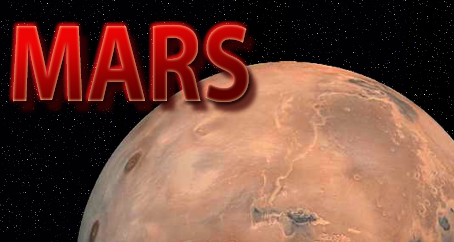Missions to Mars
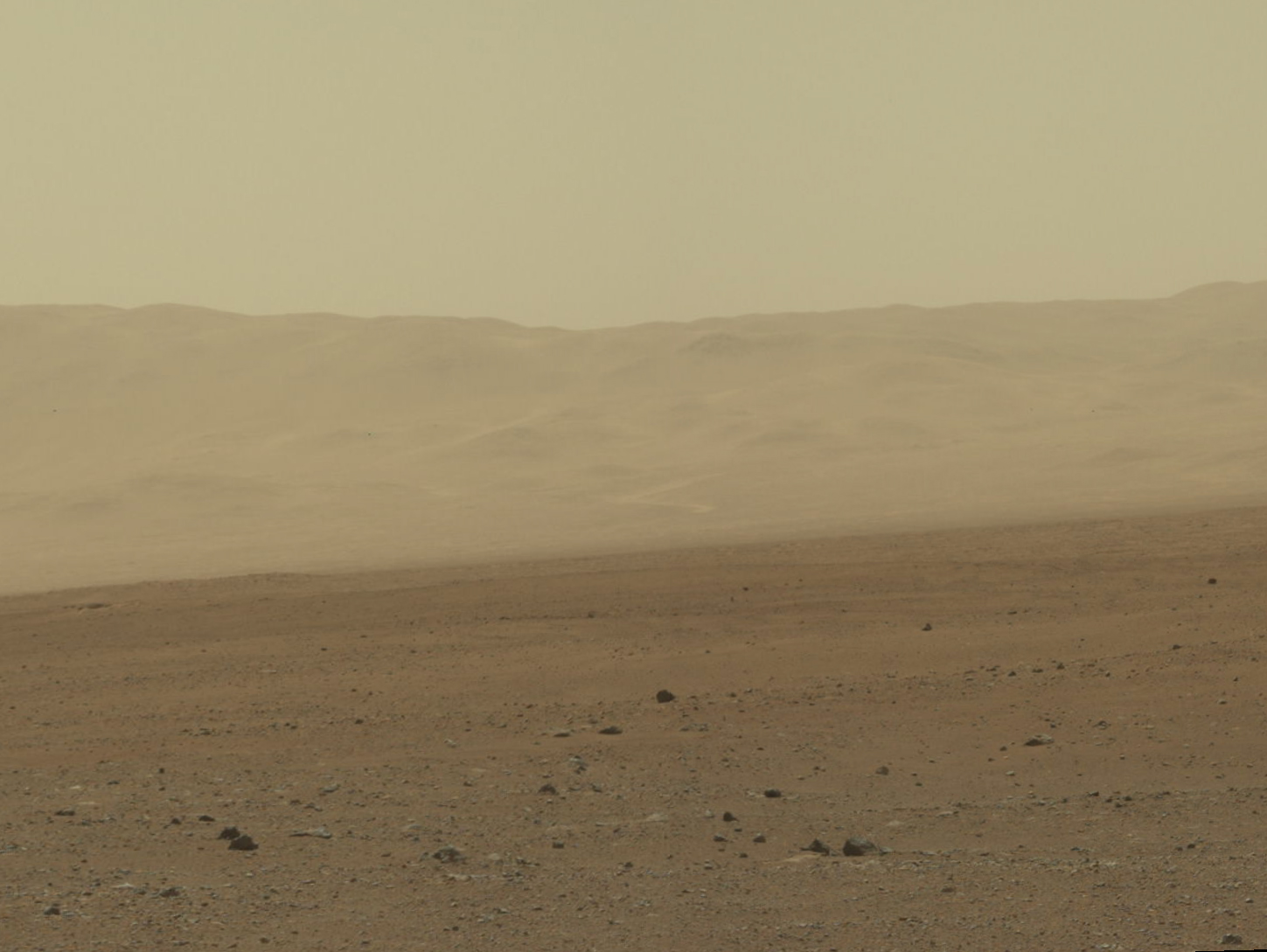
Mars is probably the most popular planet in the Solar System for exploration. Although it is further away from Earth than Venus is, it is definitely a much more 'welcoming' planet. Scientists believe that, if any other planet in the Solar System is able to support life or has done so in its past, that planet will be Mars. Evidence exists to suggest that the planet once had flowing water. The presence of water immediately increases the chances of the existence of some sort of life, no matter how basic or primitive this form of life is. However, exploration of Mars isn't just to find life, or signs of life in the past. It is also to find out about the planet's history and how the planet formed. This may hold clues to how the Solar System and Earth formed. If the planets formed out of the same cloud of dust spinning around the Sun, Mars should contain the same sorts of rocks as Earth. By finding out why life doesn't exist on Mars, we can also find out why it exists on Earth. And, if we do find signs that life did once exist there, we could try to find out why it ended. This may give us clues to what will happen to life on Earth.
Exploration of Mars
began over 100 years ago in 1877 when an Italian astronomer called Giovanni Schiaparelli drew pictures of the surface of Mars, observing
what he thought were canals (or channels), possibly built by a sophisticated civilisation. These pictures, such as the one below,
were still being used when more advanced scientific exploration of Mars began in 1964.
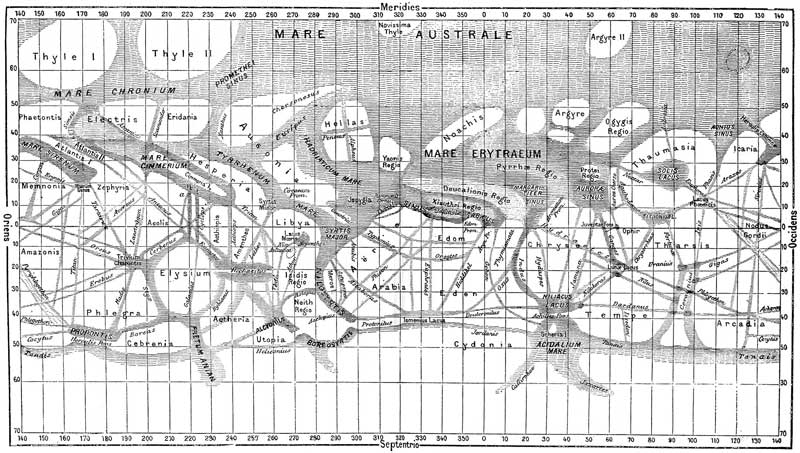
Mariner 4 (USA) was the first probe to visit Mars. It was a 'Flyby' mission, simply meaning that it flew by Mars and took pictures of the planet. These were to become the first close-up pictures of the planet. These pictures (such as the one at the top of the page) disappointed scientists who discovered no canals on the surface, but thousands of craters, just like the ones seen on the Moon. Four years later, just after the first men walked on the Moon, Mariners 6 and 7 took more pictures of Mars. They were similar to the ones from Mariner 4. Scientists were again disappointed, describing the planet as being "as dead as a dodo." Mariner 9 in 1971-1972 was put into orbit around Mars to take pictures of the entire planet's surface. However, at the time, Mars was covered in a dust storm meaning the surface of the planet was not visible. Towards the end of the mission though, four peaks appeared above the clouds of dust. These peaks turned out to be volcanoes. This was the first sign of any geological life on Mars! The largest volcano seen by Mariner 9 is also the largest known volcano in the entire Solar System. It is called Olympus Mons and is three times higher than Mount Everest, Earth's largest mountain. The picture below shows Olympus Mons from overhead. It may seem small, but that picture is actually 600 kilometres (373 miles) across!
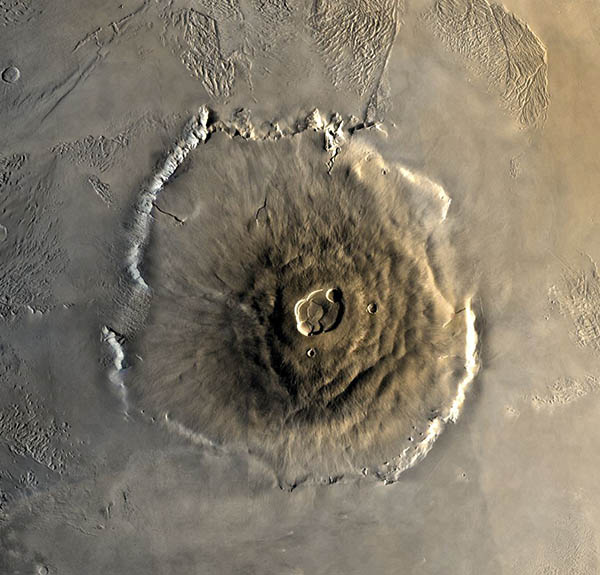
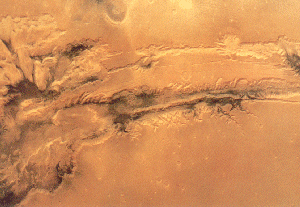
Mariner 9 also discovered a huge gorge, 4, 000 kilometres (2,485 miles) long and 7 kilometres (4.3 miles) deep, which scientists believe was formed when the four volcanoes erupted and tore up the land. This is known as Valles Marineris and can be seen sprawling across the surface of Mars in the picture on the right.
Also visible were lava plains (caused by the volcanoes), landslides and channels where water had flowed! The presence of volcanoes shows that Mars had a hot core, just like the Earth. But, does the planet still have a hot core? Can volcanoes still erupt on the planet? The Americans, in 1975, launched the Viking probes. These were probes that landed on the planet's surface to take pictures from the surface and sense rumblings under the surface which would suggest volcanic activity. Viking 1 took the very first pictures of Mars, revealing a rocky red desert, and a pink sky.
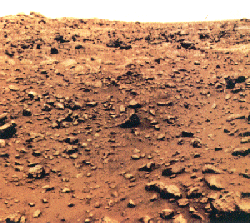
Viking 1's seismometers (sensors which detect underground rumbles - these are used on Earth to detect earthquakes) failed to work. Viking 2, which was designed to do the same thing, only succeeded in detecting wind on the planet and took more pictures. After the Viking Mission of the 1970s, Mars was largely ignored until the late 1990s. Pathfinder arrived on Mars in 1997 to take more pictures and, using its Rover, the Sojourner Rover, analysed rock samples to find out what the rocks on Mars were actually made of. Below is a picture of the Sojourner Rover examining a rock named Yogi.
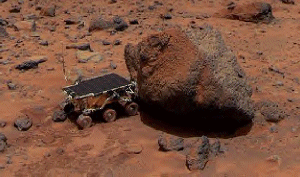
This mission was extremely successful, lasting much longer than scientists expected. Pathfinder also discovered that Mars must have an iron core, just like the Earth's. The Earth's outer core is still molten, which is what causes the internal heat on the planet and volcanic eruptions. There is a possibility that Mars' outer core is also still molten which is something scientists still hope to find out in the future. Launched at a similar time to Pathfinder was Mars Global Surveyor which went into an orbit of Mars and looked at the planet in great detail. It observed that there are places where boulders have recently rolled down slopes. Could this have happened because of Mars' wind, or because of underground rumblings? The Mars Global Surveyor has also sent back some other interesting pictures, a heart and a smiley face! Contact with the spacecraft was lost in 2006,


The years that followed the launches of Pathfinder and Mars Global Surveyor have
seen several successes and some failures.
The Mars Polar Lander landed on Mars on 3rd December 1999, but contact was lost
around the time it should have hit the surface and it hasn't been heard of
since. Mars Express successfully entered into an orbit of Mars, but a rover that
it attempted to send to its surface (Beagle 2) suffered the same fate as Mars
Polar Lander, and contact was lost. However, more successful is the mission of
the two Mars Exploration Rovers, Spirit and Opportunity. Both landed on Mars in
January 2004 and were expected to last 3 months. The last contact with Spirit
was in March 2010, with the final attempt to communicate with it occurring in
May 2011. Opportunity however, is still in operation, even though some of its
bits and pieces no longer work and it has to travel backwards! For more
information about the more recent visits to Mars and what the future may hold,
see Missions to Mars - Part 2!
